2. 自然资源部矿产勘查技术指导中心, 北京 100037;
3. 《中国工程科学》杂志社, 北京 100029;
4. 河北省地矿局第三地质大队, 张家口 075000;
5. 成都理工大学地球科学学院, 成都 610059
2. Mineral Exploration Technical Guidance Center, Ministry of Natural Resources, Beijing 100037, China;
3. Engineering Sciences Press, Beijing 100029, China;
4. The Third Geological Brigade of Hebei Bureau of Geology and Mineral Resources, Zhangjiakou 075000, China;
5. College of Earth Science, Chengdu University of Technology, Chengdu 610059, China
南岭地处早中生代EW向印支期特提斯构造域和晚中生代燕山期NE向太平洋构造域叠置部位,成矿条件优越,是我国重要的金属矿产资源产地,以中生代钨锡矿大爆发而著名,发育有柿竹园、香花岭、瑶岗仙、芙蓉、西华山、大吉山等一大批超大型-大型钨锡多金属矿床,因而长期受到国内外地学界的广泛关注(Hsu, 1943; 徐克勤等, 1982; 韦昌山等, 2004; 华仁民等, 2005; 舒良树等, 2006; 陈骏等, 2014; 袁顺达, 2017; Legros et al., 2020; Xiong et al., 2020)。长期以来,许多学者对该区钨锡矿成矿花岗岩开展了大量的研究工作(徐克勤等, 1982; 黄汲清和陈廷愚, 1986; 裴荣富和毛景文, 1989; 周新民, 2003; 毛景文等, 2004; 王汝成等, 2017),认为钨锡矿主要与高分异的A型和S型花岗岩有关(蒋少涌等, 2008; 朱金初等, 2008; Jiang et al., 2009; Qiu et al., 2017)。其中,与锡矿有关A型花岗岩广泛分布于钦-杭带与南岭地区交汇部位,具有大量镁铁质包体和较高的岩浆熔融温度,这些特征被认为是幔源岩浆活动的重要证据(Yuan et al., 2019)。但有关钨锡大规模成岩成矿的地球动力学环境,一直没有取得共识,在一定程度上影响着新一轮地质与找矿工作的方向与思路(周新民, 2003; Mao et al., 2018)。
湖南大义山锡矿位于南岭成矿带和钦-杭成矿带(简称钦-杭带)的交汇部位,是南岭地区重要的锡多金属矿集区。经过多年的地质找矿工作,已发现狮形岭、狮茅冲、白沙子岭等一大批中型及以上锡多金属矿床(伍光英等, 2005),取得了重要找矿进展(曾钦旺等, 2016)。前人对大义山地区与花岗岩有关锡多金属矿床开展了广泛的研究工作,主要包括区域成矿规律(伍光英等, 2005)、成矿地质特征与控矿要素(周厚祥等, 2005; 曾志方, 2013)、矿床成因(刘铁生, 2002)、成矿动力学背景(孔华等, 2014)、成矿花岗岩成因和侵位就位机制(费利东等, 2012)、成矿年代学(孔华等, 2014; 张晓军等, 2014; Sun et al., 2018; Zhang et al., 2021)、深部找矿预测(吴迎春等, 2008; 贺文华, 2011; 曾钦旺等, 2016)以及找矿方向探索(李惠纯, 2000)等。野外调查发现,大义山地区锡矿成矿花岗岩和锡矿化广泛发育电气石,具有明显的富硼特征,与南岭地区多数锡矿富氟的特征存在一定差别(袁顺达, 2017)。目前,关于大义山锡矿成矿花岗岩的成因类型及动力学背景仍缺乏系统的研究。本文拟通过对大义山地区锡矿成矿花岗岩系统的主量元素、微量元素和Sr-Nd-Hf同位素组成研究,厘定花岗岩的成因,探讨其形成的动力学背景,为深入理解该区复杂的成岩成矿作用提供重要的科学依据。
1 区域地质背景湖南大义山锡矿位于南岭成矿带和钦-杭带的交汇部位,邻区发育有一大批超大型-大型钨锡多金属矿床(图 1)。区内除缺失志留纪、古近-新近纪地层外,其他地层围绕大义山岩体周边多有分布(图 2)。震旦系-寒武系主要为一套浅海相类复理石沉积建造,出露于大义山岩体西南。震旦系岩性以石英砂岩夹砂质板岩、板岩、长石石英砂岩为主;寒武系岩性以浅变质砂岩类为主,夹杂泥质及粉砂质板岩类。晚古生界为陆缘海浅海相碳酸盐沉积为特征;其中泥盆系主要为中厚层石英砂岩、砂岩、粉砂岩以及中厚层至厚层灰岩、白云质灰岩;石炭系主要为中厚层灰岩、白云岩以及石英砂岩、粉砂岩、页岩等;二叠系岩性主要为中厚层灰岩、含铁锰硅质岩、硅质页岩以及石英砂岩、粉砂岩。泥盆、石炭系碳酸盐岩与岩体接触部位往往形成矽卡岩型锡多金属矿,另外岩体周边河谷多赋存有砂锡矿(曾志方, 2013)。
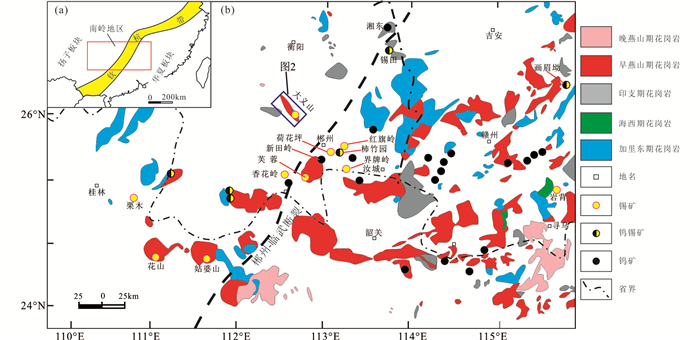
|
图 1 南岭地区构造位置图(a)和华南中生代花岗质侵入岩及主要钨锡矿床分布图(b)(据Sun et al., 2018) Fig. 1 Simplified tectonic map of Nanling Range (a) and the distribution of granitoids and W-Sn deposits in this area (b) (after Sun et al., 2018) |
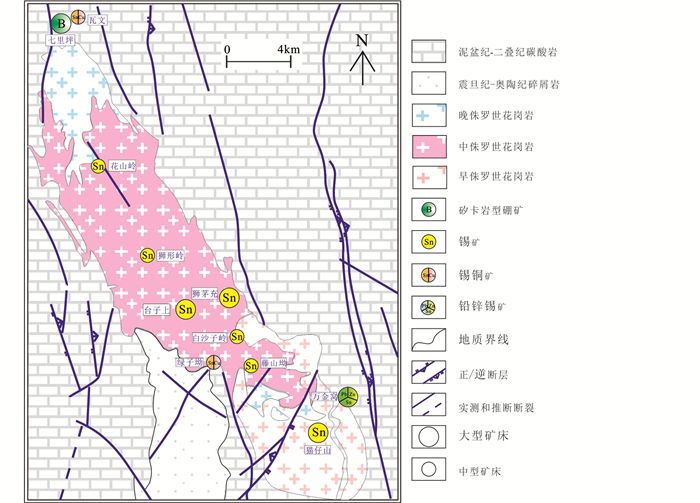
|
图 2 大义山锡矿地质简图(据Sun et al., 2018) Fig. 2 The simplified tectonic map of the Dayishan Sn deposit (after Sun et al., 2018) |
大义山地区经历了多期构造活动,形成了以断裂为主、褶皱次之的构造格局(张晓军等, 2014)。阳明山-塔山岩体东西向构造带与大义山岩体北西向构造带形成该区域的主干构造,其中“大义山式”北西向张扭性断裂构造具有继承性发展的特征,控制了大义山花岗岩体的侵入活动(曾钦旺等, 2016)。基底层褶皱-泗洲山复背斜呈北北东向展布,其余褶皱轴向多呈近南北向-北北西向展布,紧靠岩体部位多被断层所破坏(伍光英等, 2005)。
大义山花岗岩体为燕山期花岗岩,受北西向邵阳-郴州基底断裂严格控制,沿北西向构造带多期次侵位,平面上呈扁长椭圆状,长轴走向北西(NW 325°),呈长条状侵入于印支期构造层之中。按侵入期次,该岩体可分为三期,分别为早侏罗世中-细粒斑状(含角闪石)黑云钾长花岗岩、中侏罗世中粗-细(微)粒斑状黑云二长花岗岩及细粒(少斑)二云二长花岗岩、晚侏罗世中细-细(微)粒二长花岗岩。区内与大义山岩体有关矿化以锡矿为主,铜矿、铅锌矿次之,主要有蚀变花岗岩型、云英岩脉型、石英脉型、矽卡岩型等,并在岩体外围有大量砂锡矿分布(张晓军等, 2014)。Sun et al. (2018)通过蚀变花岗岩型锡矿、云英岩脉型锡矿锡石U-Pb年龄、成矿黑云母二长花岗岩锆石U-Pb年龄及晚期含辉钼矿石英脉中辉钼矿Re-Os年龄精确限定了大义山锡矿猫仔山矿区锡矿成矿年龄为~156Ma。Zhang et al. (2021)通过对大义山藤山坳矿区锡石及成矿花岗岩U-Pb测年和白云母40Ar-39Ar测年,也获得了相近的结果。
2 岩石特征本次研究样品全部为猫仔山矿区坑道样品,为似斑状黑云母二长花岗岩,其成岩年龄为~156Ma (Sun et al., 2018)。花岗岩具似斑状结构,块状构造。主要成分为石英、斜长石、钾长石和少量黑云母。钾长石为自形-半自形板状,可见卡巴斯双晶,部分蚀变为绢云母,粒径为0.2~0.4cm,含量约34%;石英为他形粒状,具明显的溶蚀结构,粒径0.1~0.5cm,含量为30%左右;斜长石为半自形板状-他形粒状,粒径为0.1~0.3cm,含量为30%左右;黑云母为半自形鳞片状,粒径0.3~0.2mm,含量5%左右,局部可见电气石“囊包”(图 3)。
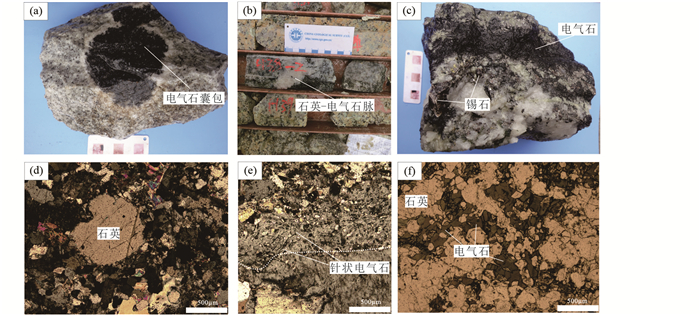
|
图 3 大义山锡矿成矿花岗岩及矿石典型样品照片 (a)含电气石囊包黑云母二长花岗岩;(b)贫矿含电气石石英脉;(c)含锡石电气石-石英脉;(d)港湾状石英斑晶(正交偏光);(e)巨斑状黑云母二长花岗岩与似斑状黑云母二长花岗岩接触界线附近发育大量针状电气石(单偏光);(f)电气石囊包中粒状电气石(单偏光) Fig. 3 The samples of metallogenic granite and typical ore in the Dayishan Sn deposit (a) biotite monzogranite bearing tourmaline nodule; (b) barren quartz-tourmaline vein; (c) quartz-tourmaline vein bearing cassiterite; (d) dissolved quartz in porphyry biotite monzogranite (CPL); (e) tourmaline needles in the margin area of biotite monzogranite (PPL); (f) tourmaline grains in the tourmaline nodule (PPL) |
全岩主量元素分析在澳实分析检测(广州)有限公司完成,检测仪器为X荧光光谱仪。按要求制备的定量样品煅烧后加入Li2B4O7-LiBO2助熔物,充分混和后,放置在自动熔炼仪中,使之在1000℃以上熔融;熔融物倒出后形成扁平玻璃片,再用X射线荧光光谱分析。本方法分析的结果以氧化物表示,分析精度优于5%。
3.2 微量、稀土元素分析微量及稀土元素分析在中国科学院地球化学研究所矿床地球化学国家重点实验室完成,分析仪器均为电感耦合等离子体质谱仪(ICP-MS),分析精度优于5%。样品处理过程如下:准确称取50mg样品(200目)放入装有洗净的聚四氟乙烯塑料溶样罐的不锈钢衬套中,加入1mL HF,在电热板上蒸干以去掉大部份SiO2,再加入1mL HF和0.5mL HNO3,盖上盖子拧紧,在烘箱中于200℃分解40小时,取出冷却后,于电热板上低温蒸干,加入1mL HNO3再蒸干,重复一次;最后加入2mL HNO3和5mL蒸馏水,重新盖上盖子密封,于130℃溶解残渣3小时,再取出,冷却后加入500ng Rh内标溶液,转移至50mL离心管中上机测试,具体分析过程参见Qi and Grégoire (2000)。
3.3 全岩Sr-Nd同位素全岩Sr-Nd同位素分析在天津地质调查中心实验测试室采用TRITON热电离质谱测定。测试前,首先取200目的岩石粉末样,烘干后完全溶解于HF+HClO4+HNO3的混合酸中,用AG50W×12强酸性阳离子交换树脂分离Rb、Sr,然后用HEHEHP树脂(P507)技术分离纯化Nd。采用阳离子交换树脂分离提纯出Sr和Nd。Sr、Nd同位素比值分别采用86Sr/88Sr=0.1194、146Nd/144Nd=0.7219进行质量分馏校正。87Rb/86Sr和147Sm/144Nd比值用全岩Rb、Sr、Sm和Nd含量计算,λRb-Sr=1.42×10-12a-1;Sm-Nd同位素计算过程中,球粒陨石值、亏损地幔值和大陆地壳平均值的计算参数分别为:(143Nd/144Nd)DM=0.51315,(147Sm/144Nd)DM=0.21360,(147Sm/144Nd)cc=0.11800;λSm-Nd=6.54×10-12a-1。
3.4 锆石Hf同位素锆石分选在首钢地质勘查院进行。机械性粉碎含有锆石的岩石样品至80目,重力磁力分选后利用双目镜把锆石颗粒挑出。挑选出的锆石样品在北京锆年领航科技有限公司完成制靶和阴极发光照相。在双目镜下,选择透明、无包裹体、无裂隙、晶型好、颗粒较大的锆石单矿物粘在双面胶上,利用无色透明的环氧树脂固定,待环氧树脂固化后,将锆石抛光,使其内部结构剖面充分暴露。制靶完毕后,对样品进行阴极发光图像(CL)的采集,以便观察锆石的内部结构,帮助选择适宜的测试点位。单颗粒锆石的激光剥蚀等离子体质谱(LA-ICP-MS)原位测试锆石U-Pb同位素完成后,选择对应年龄分析位置,在中国地质大学(武汉)地质过程与矿产资源国家重点实验室对所测试锆石进行原位Hf同位素分析。实验在多接收等离子体质谱仪(MC-ICP-MS)上进行。激光束直径为44μm,剥蚀频率为8Hz,每8个测点添加1个91500标样进行控制,详细的仪器操作条件和数据处理方法见(Hu et al., 2012)。
4 分析结果 4.1 主量元素特征黑云母二长花岗岩主量元素具有相对富SiO2(73.58%~74.76%)、Al2O3(13.67%~14.00%)、Na2O(3.65%~3.90%)、K2O(3.49%~4.24%),贫Fe2O3T(1.18%~2.18%)、MgO(0.04%~0.06%)、CaO(0.54%~0.59%)、P2O5(0.04%~0.06%)的特点(表 1)。全碱含量较高,Na2O+K2O为7.30%~8.03%,平均为7.76%;K2O/Na2O值为0.92~1.12。在TAS分类图解中,样品落入亚碱性花岗岩区域(图 4a);A/CNK值为1.15~1.26,A/NK值为1.26~1.39,在A/NK-A/CNK分类图解中,落入过铝质范围内(图 4b);SiO2-K2O图解显示岩石具有高钾钙碱性的特征(图 4c)。
|
|
表 1 湖南大义山锡矿黑云母二长花岗岩主量元素(wt%)和微量元素(×10-6)分析结果 Table 1 Major (wt%) and trace elements (×10-6) of biotite monzonite in the Dayishan tin deposit |
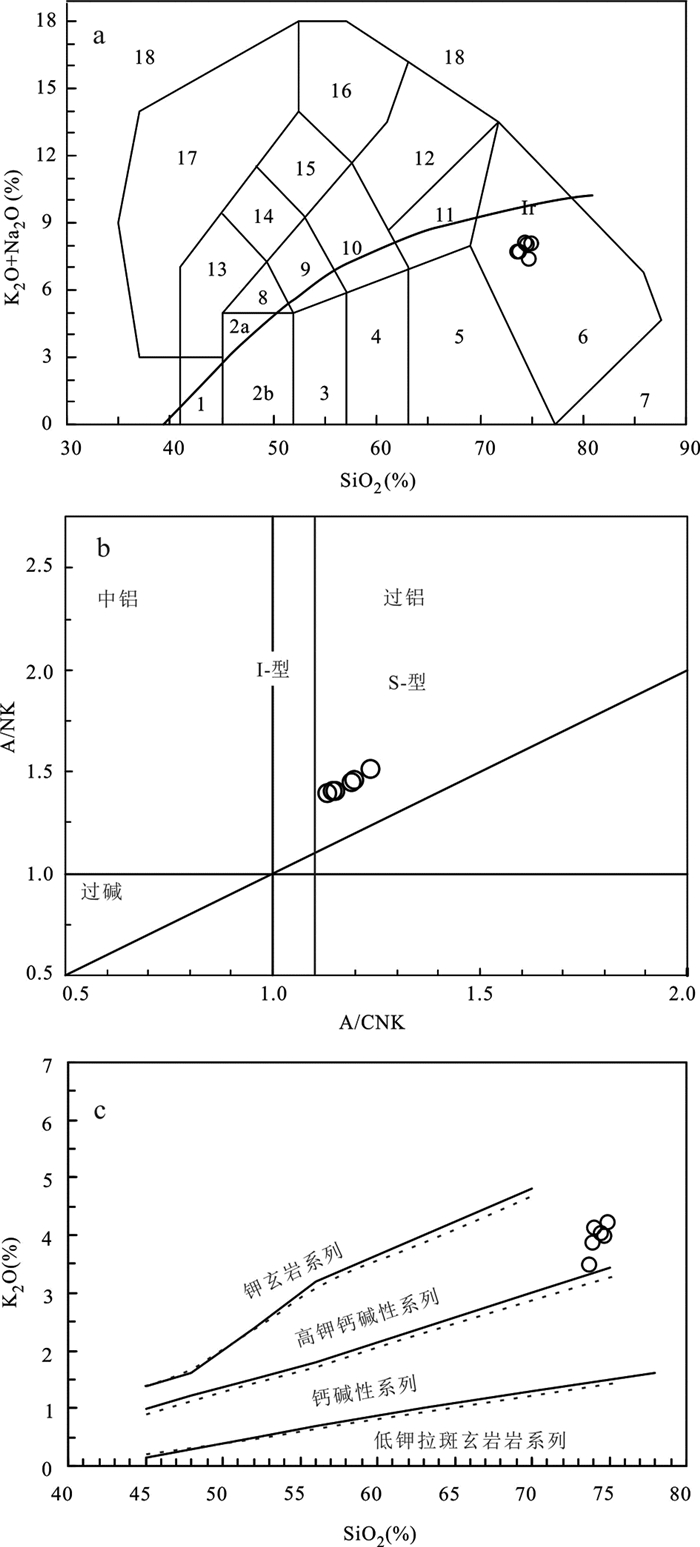
|
图 4 大义山黑云母二长花岗岩主量元素地球化学判别图 (a)全碱-硅图解(Middlemost, 1985);(b)A/NK-A/CNK判别图(Peccerillo and Taylor, 1976);(c) SiO2-K2O图解(Rickwood, 1989) Fig. 4 TAS (a, after Middlemost, 1985), A/NK vs. A/CNK (b, after Peccerillo and Taylor, 1976) and K2O vs. SiO2 (c, after Rickwood, 1989) diagrams of the Dayishan biotite monzonite |
花岗岩样品稀土元素总量较低(126×10-6~147×10-6),LREE/HREE比值为3.17~3.44,(La/Yb)N为2.23~2.59,δEu值为0.06~0.07 (表 1)。在球粒陨石标准化稀土元素配分图解中,样品表现出相对富集轻稀土元素、贫重稀土元素的特点,但轻、重稀土元素分馏不明显,稀土元素配分曲线为缓右倾的“V”型,具有强烈的Eu负异常(图 5a)。在微原始地幔标准化量元素蛛网图中,样品富集Rb、Th、U、Ta和Nd等元素,亏损Ba、Nb、Sr、Eu等元素(图 5b)。
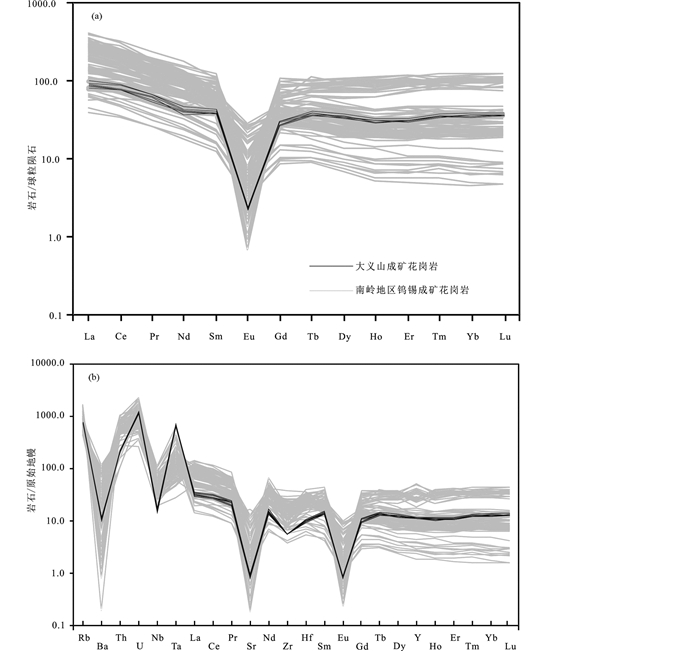
|
图 5 大义山锡矿黑云母二长花岗岩球粒陨石标准化稀土元素配分图解(a)和原始地幔标准化微量元素蛛网图(b)(标准化数值据Sun and McDonough, 1989) 数据来自Li et al. (2007b)、Yao et al.(2014)、章荣清等(2016)、Zhang et al.(2017) Fig. 5 Chondrite-normalized REE patterns (a) and primitive mantle-normalized trace element spider diagrams (b) of the Dayishan biotite monzonite (normalization values after Sun and McDonough, 1989) The data are referenced from Li et al. (2007b), Yao et al. (2014), Zhang et al.(2016, 2017) |
本次共对3件样品进行了Sr-Nd同位素分析,数据列于表 2。87Rb/86Sr初始比值变化范围较大(0.7743~0.8212)。由于异常高的Rb/Sr和87Sr/86Sr比值,年龄校正后的Sr同位素组成具有较大的不确定性,因此初始的87Sr/86Sr比值不能用于岩石成因讨论。分析样品的fSm/Nd范围为-0.09~-0.05,在有效范围内(-0.2~0.4,Wu et al., 2000)。3件样品均具有亏损的Nd同位素组成,(143Nd/144Nd)i范围为0.512174~0.512298,εNd(t)值均为负值(-5.1~-2.7),二阶段模式年龄较集中(1.2~1.4Ga)。
|
|
表 2 湖南大义山锡矿黑云母二长花岗岩Sr-Nd同位素分析结果 Table 2 Sr and Nd isotopic compositions of biotite monzonite in the Dayishan tin deposit |
MC-29锆石样品Hf同位素分析结果(表 3,锆石年龄据Sun et al., 2018)显示,锆石初始(176Hf/177Hf)i值为0.282476~0.282536,fLu/Hf值为-0.98~-0.92,显示出较为均一的特征。计算得出的εHf(t)值为-7.03~-4.93,二阶段Hf模式年龄值为1.5~1.6Ga。
|
|
表 3 湖南大义山锡矿黑云母二长花岗岩锆石Hf同位素分析结果 Table 3 Zircon Hf isotopic compositions of biotite monzonite in the Dayishan tin deposit |
大义山黑云母二长花岗岩具有较高的SiO2(73.58%~74.76%)含量、FeOT/(FeOT+MgO)比值(0.95~0.97)、FeOT/MgO比值(18.75~32.69)、10000×Ga/Al比值(3.48~4.08)和较低的CaO (0.54%~0.59%)、P2O5(0.04%~0.06%)、MgO (0.04%~0.06%)、TiO2(0.04%~0.06%)、Ba (68.40×10-6~77.10×10-6)、Sr (16.60×10-6~20.00×10-6)含量(表 1)以及平坦的稀土元素配分曲线(图 5a)。这些特征均与A型花岗岩相似,与华南钨锡成矿花岗岩特征相近(Whalen et al., 1987; 郭春丽等, 2013; Zheng et al., 2017a, b)。其较高的Rb元素含量和Rb/Sr、Rb/Ba比值,较低的Ba、Sr、P、Nb、Ti等元素含量及CaO/(Na2O+K2O)(0.07~0.08)、Zr/Hf (19~22)和Nb/Ta (2.34~2.56)比值,以及强烈的Eu负异常特点,也显示出高度结晶分异的特点。一般认为,当A型花岗岩受到结晶分异作用影响时,会与S型花岗岩和高分异的I型花岗岩具有相似的地球化学特征(Chappell and White, 1992; King et al., 1997)。本文分析的所有岩石样品的SiO2含量均高于73.00%,A/CNK值在1.15~1.26之间,变化范围较小,平均为1.20,均为过铝质岩石(图 4b),似乎也与S型花岗岩相似。然而,其较低的P2O5(0.04%~0.06%)含量和较高的Na2O(3.65%~3.90%)含量却与S型花岗岩明显不同(King et al., 1997)。另外,尽管黑云母二长花岗岩具有较高的A/CNK (1.15~1.26)比值,但A型和I型花岗岩也可以具有弱的过铝质特征(King et al., 1997)。因此,可基本排除S型花岗岩的可能性。
锆石饱和温度计算结果显示(Watson and Harrison, 1983),大义山锡矿黑云母二长花岗岩浆温度的估算结果仅为716~725℃(表 1)。这与本文黑云母二长花岗岩存在显著的结晶分异特征一致。因为岩浆中锆石和褐帘石的结晶分异会造成岩A型和I型花岗岩中Zr含量的降低(King et al., 1997),因此,岩浆的实际温度应高于上述估算值。这一特征与铝质A型花岗岩产于高温岩浆(>760℃)相似(King et al., 1997)。此外,成矿花岗岩10000Ga/Al值在3.48~4.08之间,平均值为3.73,明显高于世界I和S型花岗,而与A型花岗岩3.75的比值接近(肖庆辉等, 2009)。在10000Ga/Al-Zr图解中,所有黑云母二长花岗岩样品全部落于A型花岗岩的区域(图 6a)。值得注意的是,对于高分异花岗岩,其元素含量指标的图解可能失效,因此高分异的A型和I型花岗岩的判别应予以慎重。
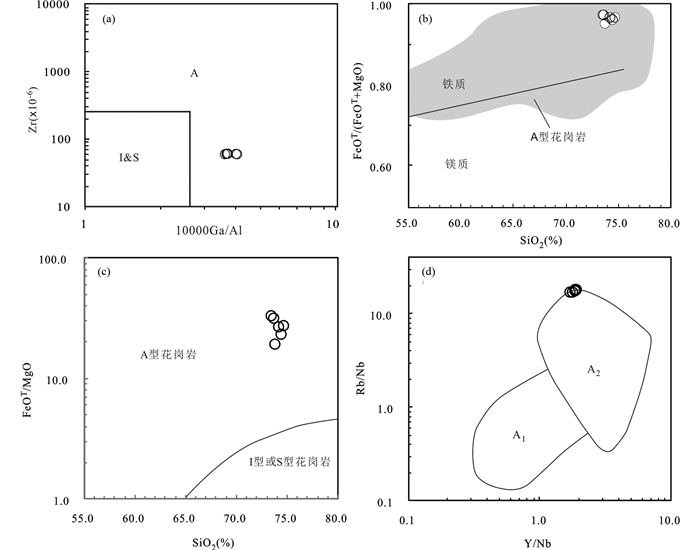
|
图 6 大义山黑云母二长花岗岩岩石类型判别图解 (a)A、I、S型花岗岩10000 Ga/Al-Zr判别图解(Whalen et al., 1987);(b)A型花岗岩SiO2-FeOT/(FeOT+MgO) 判别图解(Whalen et al., 1987);(c)A、I、S型花岗岩SiO2-FeOT/MgO判别图解(Frost et al., 2001);(d)A型花岗岩的A1亚类和A2亚类判别图(Eby, 1990) Fig. 6 Discrimination diagrams for the Dayishan mineralized biotite monzonite (a) 10000 Ga/Al vs. Zr diagram (Whalen et al., 1987); (b) SiO2 vs. FeOT/(FeOT+MgO) diagram (Whalen et al., 1987); (c) SiO2 vs. FeOT/MgO) diagram (Frost et al., 2001); (d) Y/Nb vs. Rb/Nb diagram (Eby, 1990) |
研究表明,相对于高分异的I型花岗岩,A型花岗岩具有相对较高的FeOT/MgO和FeOT/(FeOT+MgO)比值,是判别花岗岩类型的重要指标(Whalen et al., 1987; Frost et al., 2001)。本次研究的黑云母二长花岗岩具有较高的FeOT/MgO(18.75~32.69)比值和FeOT/(FeOT+MgO)(0.95~0.97)比值,表明本文研究黑云母二长花岗岩为A型花岗岩(图 6b,c)。此外,Eby (1992)根据A型花岗岩产出环境不同,将A型花岗岩划分为A1和A2型,其中,A1花岗岩形成于非造山环境,而A2花岗岩形成于陆陆碰撞或弧环境。图 6d显示,本文研究黑云母二长花岗岩样品全部落在A2型花岗岩区域,属于高分异A2型花岗岩。
值得注意的是,大义山地区恰好位于扬子、华夏两大古陆块拼贴形成的钦-杭古板块结合带和南岭成矿带的交汇部位。前人研究发现,钦-杭带的湘南-桂北地区存在一条呈北北东向展布的高εNd(t)值(>-8)和低tDM模式年龄值(< 1.5Ga)的花岗岩带,包括花山、姑婆山、骑田岭、锡田等花岗岩岩基和岩株,这些花岗岩的形成时代集中在150~165Ma,具有A型花岗岩特征,并有大量钨锡矿床伴生,被认为是一条特征独特的铝质A型花岗岩带(蒋少涌等, 2008; 朱金初等, 2008; 周云等, 2013; 陈骏等, 2014)。可见,大义山黑云母二长花岗岩可能为北东向A型锡矿花岗岩带的一部分。
5.2 岩石成因作为钦-杭带北北东向A型花岗岩的一部分(朱金初等, 2008; 赵葵东等, 2009; 王禄彬等, 2011; 周永章等, 2017),大义山成锡矿花岗岩具有相对较负的εNd(t)值(-5.1~-2.7)和年轻的Nd模式年龄(1.2~1.4Ga),以及较负的εHf(t)值(-7.03~-4.93)和年轻的Hf模式年龄(1.5~1.6Ga),与南岭地区成锡矿花岗岩及钦-杭带A型花岗岩同位素组成基本一致(图 7、图 8)(Gilder et al., 1996; 陈骏等, 2014)。洪大卫等(2002)认为该高εNd(t)值、低Nd模式年龄花岗岩带可能是地幔物质上涌加入地壳的一条重要通道,导致花岗岩的εNd(t)值升高和Nd模式年龄值降低。另外,对白沙子岭锡矿云英岩脉型锡矿中石英流体包裹体Rb和Sr同位素研究表明,其初始Sr同位素值为0.70679,与壳幔边界地区Sr初始值0.707近乎一致,也暗示石英流体包裹体中的成矿热液除了壳源物质外,还可能有地幔物质的混入(张晓军等, 2014)。邻区芙蓉锡矿床中成矿流体的稀有气体同位素3He/4He测定值为0.14~2.95Ra,也具有壳、幔混合的特点(李兆丽等, 2006; 单强等, 2014)。
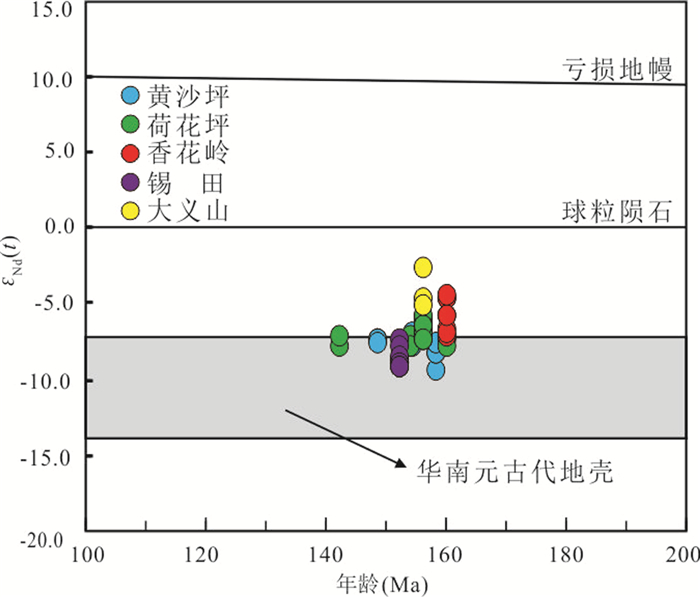
|
图 7 大义山及南岭地区主要钨锡矿床成矿花岗岩全岩εNd(t)-t相关图解 数据来源:黄沙坪矿床成矿花岗岩(Hu et al., 2017)、荷花坪成矿花岗岩(蔡明海等, 2013; 王显彬等, 2013; 章荣清等, 2016)、香花岭花岗岩(邱瑞照等, 2003)、锡田花岗岩(Zhou et al., 2015)和本文;华南元古代地壳(Shen et al., 1996) Fig. 7 Plot of intrusive age t vs. εNd(t) for the mineralized granites in the Dayishan Sn deposit Data sources: mineralized granites are sourced from Huangshaping granite (Hu et al., 2017), Hehuaping granite (Cai et al., 2013; Wang et al., 2013; Zhang et al., 2016), Xianghualing granite (Qiu et al., 2003), Xitian granite (Zhou et al., 2015) and Dayishan granite of this work; The Proterozoic crustal data of South China (Shen et al., 1996) |
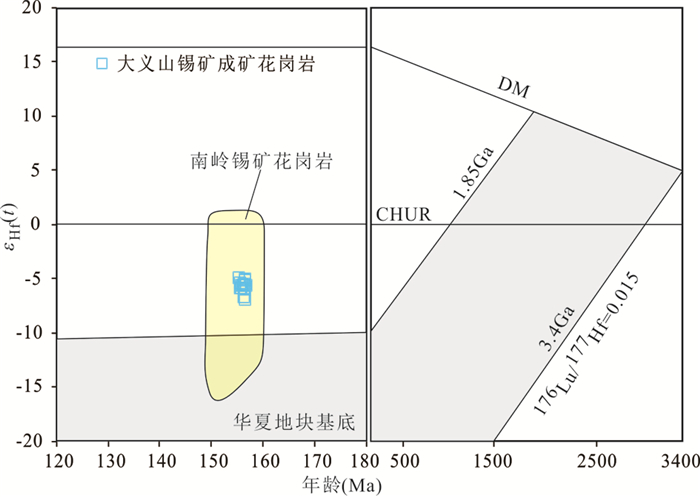
|
图 8 湖南大义山锡矿成矿花岗岩锆石Hf同位素εHf(t)-锆石年龄图 南岭地区锡矿花岗岩和华夏板块基底岩石Hf同位素数据据Liu et al. (2017)及所引用文献 Fig. 8 Plot of intrusive age t vs. εHf(t) for the mineralized granites in the Dayishan Sn deposit The data of tin mineralized granite and Hf isotope data of Cathaysia block basement from Nanling area from Liu et al., 2017 and references therein |
如上文所述,大义山锡矿黑云母二长花岗岩母岩浆经历了显著的结晶分异作用。其Ba、Sr、Eu的亏损指示了斜长石、钾长石的分离结晶,Nb、Ti的亏损指示了富钛铁矿物(钛铁矿、金红石)的分离结晶。值得注意的是,大义山锡矿成矿花岗岩轻、重稀土配分呈“V”型展布特征,具有明显的四分组效应(图 5a)。据研究,具有稀土元素四分组效应的花岗岩几乎全都是岩浆作用晚阶段残余熔体的产物(赵振华等, 1999; Peretyazhko and Savina, 2010)。强烈的结晶分异会使挥发分在残余熔体中富集,为流体-熔体相互作用提供物质基础。富挥发分的流体对熔体中的稀土元素具有很大的萃取能力,影响稀土元素在熔体和流体之间的分配,使得残余熔体形成稀土元素四分组效应(赵振华等, 1999)。稀土元素四分组效应的存在,表明该花岗岩在地壳深部部分熔融形成初始岩浆之后,岩浆上升侵位过程中经历了高度的结晶分异,进而形成了富挥发分的流体和熔体共存的体系,并经历了与流体的相互作用。
研究表明,四分组效应仅见于高度演化且富H2O、CO2、Li、B、Cl、F等元素的火成岩中,为与热液发生强烈相互作用的晚期岩浆分异产物(薛怀民等, 2009)。这与大义山成矿花岗岩中常见的“电气石”囊包及石英溶蚀现象一致(图 3a,d,f)。这种囊包多具双层结构,即内部黑色内核(主要由电气石、石英以及少量微斜长石和钠长石组成)和外部淡色环晕(为富含石英而不含黑云母的淡色花岗岩)(Sinclair and Richardson, 1992; Trumbull et al., 2008; Drivenes et al., 2015)。此结构在一些富硼成锡矿花岗岩体系中较为常见,如玻利维亚锡矿省(Lehmann et al., 1990)、英格兰西南部锡矿省(Drivenes et al., 2015)、东南亚锡矿省、内蒙古大兴安岭西南段磨盘山锡矿(Duan et al., 2020)、云南云龙锡矿(Yu and Jiang, 2003)以及桂北锡多金属矿集区(Zhao et al., 2019),是岩浆-热液过渡态的一种表现形式(Yang and Jiang, 2012; Lira and Poklepovic, 2017; Duan et al., 2020; Hong et al., 2020; 郭佳等, 2020)。花岗质岩浆中较高的硼含量可以较大程度降低岩浆的结晶温度,提升岩浆中水的溶解度,促进岩浆的结晶分异,有利于锡在岩浆中的富集,提升岩浆的锡成矿能力(Pollard et al., 1987)。大义山锡矿广泛发育的电气石化蚀变,指示成锡花岗岩具有富挥发分硼的特征。综上表明大义山富硼的成锡花岗岩源于壳源岩浆和幔源岩浆的混合,并经历了强烈的结晶分异和流体出溶作用。
5.3 构造环境前文研究表明,大义山锡矿成矿花岗岩为A2型花岗岩(图 6d)。一般认为,A2型花岗岩形成于各种类型的伸展环境中,从大陆弧或弧后到碰撞后以及板内都可以形成(Whalen et al., 1987; Eby, 1992; Förster et al., 1997)。在构造环境判别图解上(图 9),大义山锡矿成矿花岗岩全部落在后碰撞花岗岩和板内花岗岩区域的重叠部分,这一特征与南岭地区成钨锡花岗岩一致(图 9),指示花岗岩形成于伸展构造背景。大义山岩体内部流动构造不发育,接触带泥盆系-石炭系围岩形态基本上保持了原状,岩浆呈“被动”侵位的特征,也证实了这一认识(伍光英等, 2000)。另外,南岭地区在燕山早期存在碱性玄武岩(177~178Ma)、双峰式火山岩(158~179Ma)和A型花岗岩(176~178Ma)岩石组合,也暗示了华南自燕山早期就开始处于伸展的构造环境(赵振华等, 2000; 陈培荣等, 2002; Ye et al., 2013)。宁远地区玄武岩地幔包体元素地球化学和Re-Os同位素也说明,华南中生代存在岩石圈减薄过程(Liu et al., 2012)。随后该区强烈的花岗质岩浆活动亦与这种岩石圈伸展裂解作用密切相关(Gilder et al., 1996)。

|
图 9 湖南大义山锡矿成矿花岗岩Nb+Y-Rb(a)和Y-Nb构造环境判别图解(b)(据Pearce, 1996) 南岭地区钨锡矿成矿花岗岩数据引自Zhang et al. (2017)、Li et al. (2007a)、Yao et al. (2014)、Hu et al. (2017)和章荣清等(2016). Syn-COLG-同碰撞花岗岩;WPG-板内花岗岩;ORG-洋中脊花岗岩;VAG+S-COLG-碰撞和火山弧花岗岩;VAG-火山弧花岗岩;Post-COLG-碰撞后花岗岩 Fig. 9 Discrimination diagrams of Nb+Y vs. Rb (a) and Y vs. Nb (b) for the Dayishan mineralized biotite monzonite (after Pearce, 1996) 南岭地区钨锡矿成矿花岗岩数据引自Zhang et al. (2017)、Li et al. (2007a)、Yao et al. (2014)、Hu et al. (2017)和章荣清等(2016). Syn-COLG-同碰撞花岗岩; WPG-板内花岗岩; ORG-洋中脊花岗岩; VAG+S-COLG-碰撞和火山弧花岗岩; VAG-火山弧花岗岩; Post-COLG-碰撞后花岗岩 |
在中-晚朱罗世伸展背景下,南岭地区不仅形成了大量钨锡矿床,相近成矿年龄的斑岩型铜矿也屡见不鲜,如湘南地区的铜山岭铜铅锌矿(161Ma;Zhao et al., 2016)和宝山铜铅锌矿(158Ma;Zhao et al., 2017)。统计发现,南岭地区中-晚朱罗世铜铅锌矿虽与钨锡矿位置有重叠,却形成稍早(黄旭栋等, 2017),而且两期岩浆活动具有完全不同的地球化学特征,铜铅锌多金属矿床成矿斑岩具有较高的氧逸度、低初始ISr比值、高Cl、低F等特点,明显的幔源特征,而该区钨锡矿成矿花岗岩则不同,以低氧逸度、高度分异、低的εNd(t)值为特征(Ding et al., 2015及本文),说明早期铜多金属矿形成时成矿花岗岩存在受俯冲板片流体交代的幔源物质组分加入,而钨锡成矿则不存在俯冲板片来源物质组分参与(Liu et al., 2012及作者未发表的电气石硼同位素数据)。另外,沿着中国东部东南沿海越来越多的侏罗纪斑岩-矽卡岩铜多金属矿床逐渐被发现,表明存在一个中晚侏罗世的大陆岩浆弧和相关的斑岩-矽卡岩铜矿带,如德兴、永平、古田、岭后、旗鼓岭、陂头面、龙头岗、新寮岽等铜多金属矿(王小雨等,2016; Mao et al., 2017; 郑伟等, 2018a, b),指示170Ma左右Izanagi板块或古太平洋板块开始向欧亚大陆发生斜向俯冲,中国东部大陆边缘成为活动大陆边缘(Mao et al., 2021)。
近年来,岩浆岩、构造、矿床等多方面的证据也表明,华南在180~170Ma已经完成由特提斯构造域向滨太平洋构造域的转换(董树文等, 2007; 张岳桥等, 2012)。对于钦-杭成矿带,其北北东向的走向完全不同于近东西走向的印支碰撞带,而与古太平洋板块的俯冲缝合线走向一致,华仁民等(2005)、蒋少涌等(2008)和毛景文等(2018)也认为,约160Ma的华南内部拉张事件可能与古太平洋板块的俯冲消减有关,而不是后碰撞或后造山伸展减薄所致。160~150Ma,伴随着俯冲板片的后撤,俯冲板片开天窗或撕裂,软流圈物质上涌到下地壳形成壳幔源型花岗质岩浆,岩浆的分异与演化,形成了南岭大规模钨锡成矿事件(毛景文等, 2011)。因此,本文认为,~156Ma左右,Izanagi俯冲板块开天窗或撕裂,导致软流圈物质上涌到下地壳,形成了壳幔源混合型花岗质岩浆。其较高的硼含量促使岩浆经历了强烈的结晶分异,有助于岩浆演化晚期岩浆热液的出溶和锡矿化的形成。
6 结论本文对湖南大义山成锡矿黑云母二长花岗岩开展了详细的岩石学、Sr-Nd-Hf同位素和全岩主量、微量元素分析,在结合大量前人分析结果的基础上,得出如下结论:
(1) 成矿花岗岩具有较高的SiO2含量和FeOT/(FeOT+MgO)比值、FeOT/MgO比值、A/CNK比值、10000×Ga/Al比值,较低的CaO、P2O5、MgO、TiO2、Ba、Sr含量,以及较低的锆石饱和温度,这些特征均与A型花岗岩相似,属高分异的A2型花岗岩。
(2) 成矿花岗岩具有富挥发分硼的特征,Sr-Nd-Hf同位素指示大义山富硼成锡花岗岩源于壳源岩浆和幔源岩浆的混合,并经历了强烈的结晶分异和流体出溶作用。
(3) 成矿花岗岩的形成与Izanagi俯冲板块开天窗或撕裂有关。在此背景下,软流圈物质上涌到下地壳,形成了壳幔源混合型花岗质岩浆,其较高的硼含量促使岩浆经历了高度的结晶分异,有利于晚期锡矿的形成。
致谢 湖南四一八地质队陈文辉、宁勇云、毛红光在野外工作中给予了帮助与支持;中国地质科学院矿产资源研究所武广研究员、中国地质大学(北京)张德会教授及两位审稿人对本文修改提出了宝贵建议;在此一并深表谢意。
Cai MH, Wang XB, Peng ZA, Liu H, Guo TF, Tan ZM and Tang LF. 2013. Study on Sm-Nd isotope of granitoids of the Hehuaping tin-polymetallic deposit, South Hunan Province. Geotectonica et Metallogenia, 37(3): 530-538
|
Chappell BW and White AJR. 1992. I- and S-type granites in the Lachlan Fold Belt. Transactions of the Royal Society of Edinburgh: Earth Sciences, 83(1-2): 1-26 DOI:10.1017/S0263593300007720
|
Chen J, Wang RC, Zhu JC, Lu JJ and Ma DS. 2013. Multiple-aged granitoids and related tungsten-tin mineralization in the Nanling Range, South China. Science China (Earth Sciences), 56(1): 2045-2055
|
Chen PR, Hua RM, Zhang BT, Lu JJ and Fan CF. 2002. Early Yanshanian post-orogenic granitoids in the Nanling region: Petrological constraints and geodynamic settings. Science in China (Series D), 45(8): 755-768
|
Ding T, Ma DS, Lu JJ and Zhang RQ. 2015. Apatite in granitoids related to polymetallic mineral deposits in southeastern Hunan Province, Shi-Hang zone, China: Implications for petrogenesis and metallogenesis. Ore Geology Reviews, 69: 104-117 DOI:10.1016/j.oregeorev.2015.02.004
|
Dong SW, Zhang YQ, Long CS, Yang ZY, Ji Q, Wang T, Hu JM and Chen XH. 2007. Jurassic tectonic revolution in China and new interpretation of the Yanshan Movement. Acta Geologica Sinica, 81(11): 1449-1461 (in Chinese with English abstract)
|
Drivenes K, Larsen RB, Müller A, Sørensen BE, Wiedenbeck M and Raanes MP. 2015. Late-magmatic immiscibility during batholith formation: Assessment of B isotopes and trace elements in tourmaline from the Land's End granite, SW England. Contributions to Mineralogy and Petrology, 169(6): 56 DOI:10.1007/s00410-015-1151-6
|
Duan ZP, Jiang SY, Su HM and Zhu XY. 2020. Tourmaline as a recorder of contrasting boron source and potential tin mineralization in the Mopanshan pluton from Inner Mongolia, northeastern China. Lithos, 354-355: 105284 DOI:10.1016/j.lithos.2019.105284
|
Eby GN. 1990. The A-type granitoids: A review of their occurrence and chemical characteristics and speculations on their petrogenesis. Lithos, 26(1-2): 115-134 DOI:10.1016/0024-4937(90)90043-Z
|
Eby GN. 1992. Chemical subdivision of the A-type granitoids: Petrogenetic and tectonic implications. Geology, 20(7): 641-644 DOI:10.1130/0091-7613(1992)020<0641:CSOTAT>2.3.CO;2
|
Fei LD, Quan TJ, Kong H, Wang G and Guo BY. 2012. Geological and geochemical characteristics of the concealed Xinsheng granite orebodies and their relationship with the metallogeny in Yongxing County, Hunan Province. Geology and Exploration, 48(1): 110-118 (in Chinese with English abstract)
|
Förster HJ, Tischendorf G and Trumbull RB. 1997. An evaluation of the Rb vs. (Y+Nb) discrimination diagram to infer tectonic setting of silicic igneous rocks. Lithos, 40(2-4): 261-293 DOI:10.1016/S0024-4937(97)00032-7
|
Frost BR, Barnes CG, Collins WJ, Arculus RJ, Ellis DJ and Frost CD. 2001. A geochemical classification for granitic rocks. Journal of Petrology, 42(11): 2033-2048 DOI:10.1093/petrology/42.11.2033
|
Gilder SA, Gill J, Coe RS, Zhao XX, Liu ZW, Wang GX, Yuan KR, Liu WL, Kuang GD and Wu HR. 1996. Isotopic and paleomagnetic constraints on the Mesozoic tectonic evolution of South China. Journal of Geophysical Research: Solid Earth, 101(B7): 16137-16154 DOI:10.1029/96JB00662
|
Guo CL, Xu YM, Lou FS and Zheng JH. 2013. A comparative study of the Middle Jurassic granodiorite related to Cu and the Late Jurassic granites related to Sn in the Qin-Hang metallogenic belt and a tentative discussion on their tectonic dynamic setting. Acta Petrologica et Mineralogica, 32(4): 463-484 (in Chinese with English abstract)
|
Guo J, Yan HB, Ling MX and Zhang RQ. 2020. Chemical composition of tourmaline in the biotite granite, the Dachang district: Insights into magmatic-hydrothermal evolution. Acta Petrologica Sinica, 36(1): 171-183 (in Chinese with English abstract) DOI:10.18654/1000-0569/2020.01.16
|
He WH. 2011. Metallogenic model of tin polymetallic deposits of Dayishan area, Hunan Province. Geology and Mineral Resources of South China, 27(1): 14-21 (in Chinese with English abstract)
|
Hong DW, Xie XL and Zhang JS. 2002. Geological significance of the Hangzhou-Zhuguangshan-Huashan high-εNd granite belt. Geological Bulletin of China, 21(6): 348-354 (in Chinese with English abstract)
|
Hong W, Fox N, Cooke DR, Zhang LJ and Fayek M. 2020. B- and O-isotopic compositions of tourmaline constrain late-stage magmatic volatile exsolution in Tasmanian tin-related granite systems. Mineralium Deposita, 55(1): 63-78 DOI:10.1007/s00126-019-00885-5
|
Hsu KC. 1943. Tungsten deposits of southern Kiangsi, China. Economic Geology, 38(6): 431-474 DOI:10.2113/gsecongeo.38.6.431
|
Hu XL, Gong YJ, Pi DH, Zhang ZJ, Zeng GP, Xiong SF and Yao SZ. 2017. Jurassic magmatism related Pb-Zn-W-Mo polymetallic mineralization in the central Nanling Range, South China: Geochronologic, geochemical, and isotopic evidence from the Huangshaping deposit. Ore Geology Reviews, 91: 877-895 DOI:10.1016/j.oregeorev.2017.08.016
|
Hu ZC, Liu YS, Gao S, Liu WG, Zhang W, Tong XR, Lin L, Zong KQ, Li M, Chen HH, Zhou L and Yang L. 2012. Improved in situ Hf isotope ratio analysis of zircon using newly designed X skimmer cone and jet sample cone in combination with the addition of nitrogen by laser ablation multiple collector ICP-MS. Journal of Analytical Atomic Spectrometry, 27(9): 1391-1399 DOI:10.1039/c2ja30078h
|
Hua RM, Chen PR, Zhang WL, Yao JM, Lin JF, Zhang ZS and Gu SY. 2005. Metallogeneses and their geodynamic settings related to Mesozoic granitoids in the Nanling Range. Geological Journal of China Universities, 11(3): 291-304 (in Chinese with English abstract)
|
Huang JQ and Chen TY. 1986. On the problem of ploycyclic mineralization of tungsten and tin deposits in South China. Gelolgcial Review, 32(2): 138-143 (in Chinese with English abstract)
|
Huang XD, Lu JJ, Sizaret S, Wang RC, Ma DS, Zhang RQ, Zhao X and Wu JW. 2017. Petrogenetic difference between Middle-Late Jurassic Cu-Pb-Zn bearing and W bearing granites in the Nanling Range, South China: A case study of the Tongshanling and Weijia deposits in southeren Hunan Province. Scientia Sinica (Terrae), 47(7): 766-782 (in Chinese) DOI:10.1360/N072016-00234
|
Jiang SY, Zhao KD, Jiang YH and Dai BZ. 2008. Characteristics and genesis of Mesozoic A-type granites and associated mineral deposits in the southern Hunan and northern Guangxi provinces along the Shi-Hang Belt, South China. Geological Journal of China Universities, 14(4): 496-509 (in Chinese with English abstract)
|
Jiang YH, Jiang SY, Dai BZ, Liao SY, Zhao KD and Ling HF. 2009. Middle to Late Jurassic felsic and mafic magmatism in southern Hunan Province, Southeast China: Implications for a continental arc to rifting. Lithos, 107(3-4): 185-204b DOI:10.1016/j.lithos.2008.10.006
|
King PL, White AJR, Chappell BW and Allen CM. 1997. Characterization and origin of aluminous A-type granites from the Lachlan fold belt, southeastern Australia. Journal of Petrology, 38(3): 371-391 DOI:10.1093/petroj/38.3.371
|
Kong H, Fei LD, Zhong JL, Gao W, Liu SJ, Zhou WP and Quan TJ. 2014. Zircon U-Pb ages and Hf isotope and their geological significance of granites in Xinsheng deposit, Hunan Province, China. The Chinese Journal of Nonferrous Metals, 24(1): 229-238 (in Chinese with English abstract)
|
Legros H, Harlaux M, Mercadier J, Romer RL, Poujol M, Camacho A, Marignac C, Cuney M, Wang RC, Charles N and Lespinasse MY. 2020. The world-class Nanling metallogenic belt (Jiangxi, China): W and Sn deposition at 160Ma followed by 30m.y. of hydrothermal metal redistribution. Ore Geology Reviews, 117: 103302 DOI:10.1016/j.oregeorev.2019.103302
|
Lehmann B, Ishihara S, Michel H, Miller J, Rapela CW, Sanchez A, Tistl M and Winkelmann L. 1990. The Bolivian tin province and regional tin distribution in the Central Andes: A reassessment. Economic Geology, 85(5): 1044-1058 DOI:10.2113/gsecongeo.85.5.1044
|
Li HC. 2000. The prospecting significance of tourmalinization and grenization in Dayishan granite body. Hunan Geology, 19(4): 233-236 (in Chinese with English abstract)
|
Li XH, Li ZX, Li WX, Liu Y, Yuan C, Wei GJ and Qi CS. 2007a. U-Pb zircon, geochemical and Sr-Nd-Hf isotopic constraints on age and origin of Jurassic I- and A-type granites from central Guangdong, SE China: A major igneous event in response to foundering of a subducted flat-slab?. Lithos, 96(1-2): 186-204 DOI:10.1016/j.lithos.2006.09.018
|
Li ZL, Hu RZ, Peng JT, Bi XW and Li XM. 2006. Helium isotope composition of fluid inclusions and the origin of ore-forming fluids of Furong tin orefield in Hunan Province, China. Earth Science (Journal of China University of Geosciences), 31(1): 129-135 (in Chinese with English abstract)
|
Li ZL, Hu RZ, Yang JS, Peng JT, Li XM and Bi XW. 2007b. He, Pb and S isotopic constraints on the relationship between the A-type Qitianling granite and the Furong tin deposit, Hunan Province, China. Lithos, 97(1-2): 161-173 DOI:10.1016/j.lithos.2006.12.009
|
Lira R and Poklepovic MF. 2017. Tourmaline orbicules in peraluminous monzogranites of Argentina: A study case of fluid-rock interaction between leucogranite and country-rock metasediments. Journal of South American Earth Sciences, 80: 272-290 DOI:10.1016/j.jsames.2017.09.030
|
Liu CZ, Liu ZC, Wu FY and Chu ZY. 2012. Mesozoic accretion of juvenile sub-continental lithospheric mantle beneath South China and its implications: Geochemical and Re-Os isotopic results from Ningyuan mantle xenoliths. Chemical Geology, 291: 186-198 DOI:10.1016/j.chemgeo.2011.10.006
|
Liu P, Mao JW, Pirajno F, Jia LH, Zhang F and Li Y. 2017. Ore genesis and geodynamic setting of the Lianhuashan porphyry tungsten deposit, eastern Guangdong Province, SE China: Constraints from muscovite 40Ar-39Ar and zircon U-Pb dating and Hf isotopes. Mineralium Deposita, 53(6): 797-814
|
Liu TS. 2002. Geological characteristics and genesis of rock body-type tin deposits in the Dayishan ore field. Geology in China, 29(4): 411-415 (in Chinese with English abstract)
|
Mao JW, Xie GQ, Li XF, Zhang CQ and Mei YX. 2004. Mesozoic large scale mineralization and multiple lithospheric extension in South China. Earth science Frontiers, 11(1): 45-55 (in Chinese with English abstract)
|
Mao JW, Chen MH, Yuan SD and Guo CL. 2011. Geological characteristics of the Qinhang (or Shihang) metallogenic belt in South China and spatial-temporal distribution regularity of mineral deposits. Acta Geologica Sinica, 85(5): 636-658 (in Chinese with English abstract)
|
Mao JW, Xiong BK, Liu J, Pirajno F, Cheng YB, Ye HS, Song SW and Dai P. 2017. Molybdenite Re/Os dating, zircon U-Pb age and geochemistry of granitoids in the Yangchuling porphyry W-Mo deposit (Jiangnan tungsten ore belt), China: Implications for petrogenesis, mineralization and geodynamic setting. Lithos, 286-287: 35-52 DOI:10.1016/j.lithos.2017.05.023
|
Mao JW, Xie GQ, Yuan SD, Liu P, Meng XY, Zhou ZH and Zheng W. 2018. Current research progress and future trends of porphyry-skarn copper and granite-related tin polymetallic deposits in the Circum Pacific metallogenic belt. Acta Petrologica Sinica, 34(9): 2501-2517
|
Mao JW, Zheng W, Xie GQ, Lehmann B and Goldfarb R. 2021. Recognition of a Middle-Late Jurassic arc-related porphyry copper belt along the Southeast China coast: Geological characteristics and metallogenic implications. Geology, 49(5): 592-596 DOI:10.1130/G48615.1
|
Middlemost EAK. 1985. Magmas and Magmatic Rocks. London: Longman, 1-266
|
Pearce J. 1996. Sources and settings of granitic rocks. Episodes, 19(4): 120-125 DOI:10.18814/epiiugs/1996/v19i4/005
|
Peccerillo A and Taylor SR. 1976. Geochemistry of Eocene calc-alkaline volcanic rocks from the Kastamonu area, Northern Turkey. Contributions to Mineralogy and Petrology, 58(1): 63-81 DOI:10.1007/BF00384745
|
Pei RF and Mao JW. 1989. Review of new progress in tin deposits. Mineral Deposits, 8(2): 93-96 (in Chinese)
|
Peretyazhko IS and Savina EA. 2010. Tetrad effects in the rare earth element patterns of granitoid rocks as an indicator of fluoride-silicate liquid immiscibility in magmatic systems. Petrology, 18(5): 514-543 DOI:10.1134/S086959111005005X
|
Pollard PJ, Pichavant M and Charoy B. 1987. Contrasting evolution of fluorine- and boron-rich tin systems. Mineralium Deposita, 22(4): 315-321 DOI:10.1007/BF00204525
|
Qi L and Grégoire DC. 2000. Determination of trace elements in twenty six Chinese geochemistry reference materials by inductively coupled plasma-mass spectrometry. Geostandards Newsletter, 24(1): 51-63 DOI:10.1111/j.1751-908X.2000.tb00586.x
|
Qiu RZ, Deng JF, Cai ZY, Zhou S, Chang HL and Du SH. 2003. Nd isotopic characteristics and genesis of Xianghualing 430 granitic body, Hunan Province. Acta Petrologica et Mineralogica, 22(1): 41-46 (in Chinese with English abstract)
|
Qiu ZW, Yan QH, Li SS, Wang H, Tong LX, Zhang RQ, Wei XP, Li P, Wang LM, Bu A and Yan LM. 2017. Highly fractionated Early Cretaceous I-type granites and related Sn polymetallic mineralization in the Jinkeng deposit, eastern Guangdong, SE China: Constraints from geochronology, geochemistry, and Hf isotopes. Ore Geology Reviews, 88: 718-738 DOI:10.1016/j.oregeorev.2016.10.008
|
Rickwood PC. 1989. Boundary lines within petrologic diagrams which use oxides of major and minor elements. Lithos, 22(4): 247-263 DOI:10.1016/0024-4937(89)90028-5
|
Shan Q, Zeng QS, Li JK, Lu HZ, Hou MZ, Yu XY and Wu CJ. 2014. Diagenetic and metallogenic sources of Furong tin deposit, Qitianling: Constraints from Lu-Hf for zircon and He-Ar isotope for fluid inclusions. Acta Geologica Sinica, 88(4): 704-715 (in Chinese with English abstract)
|
Shen WZ, Wang DZ and Li CS. 1996. Isotope geochemical characteristics and material sources of tin-bearing porphyries in South China. Acta Geologica Sinica (English Edition), 9(2): 181-192
|
Shu LS, Zhou XM, Deng P and Yu XQ. 2006. Principal geological features of Nanling tectonic belt, South China. Geological Review, 52(2): 251-265 (in Chinese with English abstract)
|
Sinclair WD and Richardson JM. 1992. Quartz-tourmaline orbicules in the Seagull batholith, Yukon Territory. The Canadian Mineralogist, 30(3): 923-935
|
Sun HR, Zhao Z, Yan GS, Lü ZC, Huang ZL and Yu XF. 2018. Geological and geochronological constraints on the formation of the Jurassic Maozaishan Sn deposit, Dayishan orefield, South China. Ore Geology Reviews, 94: 212-224 DOI:10.1016/j.oregeorev.2018.01.033
|
Sun SS and McDonough WF. 1989. Chemical and isotopic systematics of oceanic basalts: Implications for mantle composition and processes. In: Saunders AD and Norry MJ (eds.). Magmatism in the Ocean Basins. Geological Society, London, Special Publications, 42(1): 313-345
|
Trumbull RB, Krienitz MS, Gottesmann B and Wiedenbeck M. 2008. Chemical and boron-isotope variations in tourmalines from an S-type granite and its source rocks: The Erongo granite and tourmalinites in the Damara Belt, Namibia. Contributions to Mineralogy and Petrology, 155(1): 1-18
|
Wang LB, Wang RC and Zhu JC. 2011. Accessory minerals of Lisong granite and mafic microgranular enclaves in the Guposhan area as indicators of magma mixing. Geological Journal of China Universities, 17(3): 423-435 (in Chinese with English abstract)
|
Wang RC, Xie L, Lu JJ, Zhu JC and Chen J. 2017. Diversity of Mesozoic tin-bearing granites in the Nanling and adjacent regions, South China: Distinctive mineralogical patterns. Science China (Earth Sciences), 60(1): 1909-1919
|
Wang XB, Wu J, Cai MH, Chen HW, Xie DF and Liu X. 2013. Geochemical characteristics and Sr-Nd-Hf isotopic compositon of the Yanshanian granite porphyries in the Hehuaping area of southern Hunan and their geological significance. Geology and Exploration, 49(2): 300-312 (in Chinese with English abstract)
|
Wang XY, Mao JW, Cheng YB, Liu P and Zhang XK. 2016. Zircon U-Pb age, geochemistry and Hf isotopic compositions of quartz-diorite from the Xinliaodong Cu polymetallic deposit in eastern Guangdong Province. Geological Bulletin of China, 35(8): 1357-1375 (in Chinese with English abstract)
|
Watson EB and Harrison TM. 1983. Zircon saturation revisited: Temperature and composition effects in a variety of crustal magma types. Earth and Planetary Science Letters, 64(2): 295-304 DOI:10.1016/0012-821X(83)90211-X
|
Wei CS, Cai MH, Cai JH, Wang XW, Che QJ and Du HY. 2004. Characteristics of structural control of ore deposition in South China in the Mesozoic. Journal of Geomechanics, 10(2): 113-121 (in Chinese with English abstract)
|
Whalen JB, Currie KL and Chappell BW. 1987. A-type granites: Geochemical characteristics, discrimination and petrogenesis. Contributions to Mineralogy and Petrology, 95(4): 407-419 DOI:10.1007/BF00402202
|
Wu FY, Jahn BM, Wilde S and Sun DY. 2000. Phanerozoic crustal growth: U-Pb and Sr-Nd isotopic evidence from the granites in northeastern China. Tectonophysics, 328(1-2): 89-113 DOI:10.1016/S0040-1951(00)00179-7
|
Wu GY, Peng QH and Jia BH. 2000. Geological features and emplacement mechanism of the Dayishan granitic intrusion in South Hunan. Geology and Mineral Resources of South China, 16(3): 1-7 (in Chinese with English abstract)
|
Wu GY, Pan ZF, Hou ZQ, Li JD, Che QJ and Chen HM. 2005. Ore body distribution pattern, ore-controlling factors and prospecting potentiality in the Dayishan tin deposit, Hunan Province. Geology and Prospecting, 41(2): 6-11 (in Chinese with English abstract)
|
Wu YC, Zheng BR and Tang ZH. 2008. Characteristics and ore prospecting of tin deposits in the Dayishan Area, Hunan. Geology and Prospecting, 44(4): 14-19 (in Chinese with English abstract)
|
Xiao QH, Wang T, Deng JF, Mo XX, Lu XX, Hong DW, Xie CF, Luo ZH, Qiu RZ and Wang XX. 2009. Study on Granites and Continental Crust Growth in Typical Orogenic Belts in China. Beijing: Geological Publishing House, 1-528 (in Chinese)
|
Xiong YQ, Shao YJ, Jiang SY, Zhao KD and Yan Q. 2020. Distal relationship of the Taihexian Pb-Zn-(Au) deposit to the Dengfuxian magmatic-hydrothermal system, South China: Constraints from mineralogy, fluid inclusion, H-O-Pb and in situ S isotopes. Ore Geology Reviews, 127: 103826 DOI:10.1016/j.oregeorev.2020.103826
|
Xu KQ, Sun D, Wang DZ, Liu CS and Chen KR. 1982. Two genetic series of granitic rocks in southeastern China. Acta Petrologica Mineralogica et Analytica, 1(2): 1-12 (in Chinese with English abstract)
|
Xue HM, Wang YG, Ma F, Wang C, Wang DE and Zuo YL. 2009. The Huangshan A-type granites with tetrad REE: Constraints on Mesozoic lithospheric thinning of the southeastern Yangtze craton?. Acta Geologica Sinica, 83(2): 247-259 (in Chinese with English abstract)
|
Yang SY and Jiang SY. 2012. Chemical and boron isotopic composition of tourmaline in the Xiangshan volcanic-intrusive complex, Southeast China: Evidence for boron mobilization and infiltration during magmatic-hydrothermal processes. Chemical Geology, 312-313: 177-189 DOI:10.1016/j.chemgeo.2012.04.026
|
Yao Y, Chen J, Lu JJ, Wang RC and Zhang RQ. 2014. Geology and genesis of the Hehuaping magnesian skarn-type cassiterite-sulfide deposit, Hunan Province, southern China. Ore Geology Reviews, 58: 163-184 DOI:10.1016/j.oregeorev.2013.10.012
|
Ye HM, Mao JR, Zhao XL, Liu K and Chen DD. 2013. Revisiting Early-Middle Jurassic igneous activity in the Nanling Mountains, South China: Geochemistry and implications for regional geodynamics. Journal of Asian Earth Sciences, 72: 108-117 DOI:10.1016/j.jseaes.2012.07.010
|
Yu JM and Jiang SY. 2003. Chemical composition of tourmaline from the Yunlong tin deposit, Yunnan, China: Implications for ore genesis and mineral exploration. Mineralogy and Petrology, 77(1-2): 67-84 DOI:10.1007/s00710-002-0195-2
|
Yuan SD. 2017. Several crucial scientific issues related to the W-Sn metallogenesis in the Nanling range and their implications for regional exploration: A review. Bulletin of Mineralogy, Petrology and Geochemistry, 36(5): 736-749 (in Chinese with English abstract)
|
Yuan SD, Williams-Jones AE, Romer RL, Zhao PL and Mao JW. 2019. Protholith-related thermal controls on the decoupling of Sn and W in Sn-W metallogenic provinces: Sights from the Nanling Region, China. Economic Geology, 114(5): 1005-1012 DOI:10.5382/econgeo.4669
|
Zeng QW, Peng LJ, Tian WW, Qian T, You GH, Chen YL and Long L. 2016. Deep ore exploration of the Baishaziling tungsten-tin ore district, Dayishan pluton, Hunan. Geology in China, 43(5): 1625-1636 (in Chinese with English abstract)
|
Zeng ZF. 2013. Research on tectonic ore-controlling and metallogenic mechanism of the dayishan tin field, Hunan, China. Ph. D. Dissertation. Wuhan: China University of Geosciences (in Chinese with English summary)
|
Zhang LP, Zhang RQ, Hu YB, Liang JL, Ouyang ZX, He JJ, Chen YX, Guo J and Sun WD. 2017. The formation of the Late Cretaceous Xishan Sn-W deposit, South China: Geochronological and geochemical perspectives. Lithos, 290-291: 253-268 DOI:10.1016/j.lithos.2017.08.013
|
Zhang RQ, Lu JJ, Wang RC, Yao Y, Ding T, Hu JB and Zhang HF. 2016. Petrogenesis of W- and Sn-bearing granites and the mechanism of their metallogenic diversity in the Wangxianling area, southern Hunan Province. Geocheimica, 45(2): 105-132 (in Chinese with English abstract)
|
Zhang XJ, Luo H, Wu ZH, Fan XW, Xiong J, Yang J and Nou JY. 2014. Rb-Sr isochron age and its geological significance of Baishaziling tin deposit in Dayishan ore field, Hunan Province. Earth Science (Journal of China University of Geosciences), 39(10): 1322-1332 (in Chinese with English abstract) DOI:10.3799/dqkx.2014.124
|
Zhang YQ, Dong SW, Li JH, Cui JJ, Shi W, Su JB and Li Yong. 2012. The new progress in the study of Mesozoic tectonics of South China. Acta Geoscientica Sinica, 33(3): 257-279 (in Chinese with English abstract)
|
Zhang ZZ, Ning YY, Lu YY, Cao JY, Fu JM, Zhao ZM, Guo J, Ma LY, Qin ZW and Li JF. 2021. Geological characteristics and metallogenic age of Tengshan'ao Sn deposit in Dayishan of South Hunan and its prospecting significance. Solid Earth Sciences, 6(1): 37-49 DOI:10.1016/j.sesci.2021.01.002
|
Zhao HD, Zhao KD, Palmer MR and Jiang SY. 2019. In-situ elemental and boron isotopic variations of tourmaline from the Sanfang granite, South China: Insights into magmatic-hydrothermal evolution. Chemical Geology, 504: 190-204 DOI:10.1016/j.chemgeo.2018.11.013
|
Zhao KD, Jiang SY, Zhu JC, Li L, Dai BZ, Jiang YH and Ling HF. 2010. Hf isotopic composition of zircons from the Huashan-Guposhan intrusive complex and their mafic enclaves in northeastern Guangxi: Implication for petrogenesis. Chinese Science Bulletin, 55(6): 509-519 DOI:10.1007/s11434-009-0314-0
|
Zhao PL, Yuan SD, Mao JW, Santosh M, Li C and Hou KJ. 2016. Geochronological and petrogeochemical constraints on the skarn deposits in Tongshanling ore district, southern Hunan Province: Implications for Jurassic Cu and W metallogenic events in South China. Ore Geology Reviews, 78: 120-137 DOI:10.1016/j.oregeorev.2016.03.004
|
Zhao PL, Yuan SD, Mao JW, Santosh M and Zhang DL. 2017. Zircon U-Pb and Hf-O isotopes trace the architecture of polymetallic deposits: A case study of the Jurassic ore-forming porphyries in the Qin-Hang metallogenic belt, China. Lithos, 292-293: 132-145 DOI:10.1016/j.lithos.2017.08.016
|
Zhao ZH, Xiong XL and Han XD. 1999. Discussion on the formation mechanism of the tetra-grouping effect of rare earth elements in granites: A case study of Qianlishan and Balzhe granites. Science in China (Series D), 29(4): 331-338 (in Chinese)
|
Zhao ZH, Bao ZW, Zhang BY and Xiong XL. 2001. Crust-mantle interaction and its contribution to the Shizhuyuan superlarge tungsten polymetallic mineralization. Science in China (Series D), 44(3): 266-276 DOI:10.1007/BF02882261
|
Zheng W, Mao JW, Zhao HJ, Ouyang HG, Zhao CS and Yu XF. 2017a. Geochemistry, Sr-Nd-Pb-Hf isotopes systematics and geochronological constrains on petrogenesis of the Xishan A-type granite and associated W-Sn mineralization in Guangdong Province, South China. Ore Geology Reviews, 88: 739-752 DOI:10.1016/j.oregeorev.2016.12.021
|
Zheng W, Mao JW, Zhao HJ, Zhao CS and Yu XF. 2017b. Two Late Cretaceous A-type granites related to the Yingwuling W-Sn polymetallic mineralization in Guangdong Province, South China: Implications for petrogenesis, geodynamic setting, and mineralization. Lithos, 274-275: 106-122 DOI:10.1016/j.lithos.2017.01.002
|
Zheng W, Ouyang ZX, Chen YL, Zhao HJ, Liu DH, Wu XD, Yang SH, Wang RP and Chu KL. 2018a. Re-Os age of molybdenite and ore-forming material source of the Qiguling Cu-W-Mo polymetallic deposit in the southern section of the Qinghang metallogenic belt. Acta Geologica Sinica, 92(1): 94-106 (in Chinese with English abstract)
|
Zheng W, Mao JW, Ouyan Z X, Zhao CS, Yu XF, Zhao HJ, Liu DH and Wu XD. 2018b. Geochronology of Potoumian Cu polymetallic deposit in Yangchun basin, zircon trace element and geological implications. Acta Petrologica Sinica, 34(9): 2671-2686 (in Chinese with English abstract)
|
Zhou HX, Yang GH, Jiang ZH and Chen QC. 2005. Geological characteristics and origin of the Dayishan tin orefield in Nanling region. Geology and Mineral Resources of South China, 21(2): 87-94
|
Zhou XM. 2003. My thinking about granite geneses of South China. Geological Journal of China Universities, 9(4): 556-565
|
Zhou Y, Liang XQ, Liang XR, Wu SC, Jiang Y, Wen SN and Cai YF. 2013. Geochronology and geochemical characteristics of the Xitian tungsten-tin-bearing A-type granites, Hunan Province, China. Geotectonica et Metallogenia, 37(3): 511-529 (in Chinese with English abstract)
|
Zhou Y, Liang XQ, Wu SC, Cai YF, Liang XR, Shao TB, Wang C, Fu JG and Jiang Y. 2015. Isotopic geochemistry, zircon U-Pb ages and Hf isotopes of A-type granites from the Xitian W-Sn deposit, SE China: Constraints on petrogenesis and tectonic significance. Journal of Asian Earth Sciences, 105: 122-139 DOI:10.1016/j.jseaes.2015.03.006
|
Zhou YZ, Li XY, Zheng Y, Shen WJ, He JG, Yu PP, Niu J and Zeng CY. 2017. Geological settings and metallogenesis of Qinzhou Bay-Hangzhou Bay orogenic juncture belt, South China. Acta Petrologica Sinica, 33(3): 667-681 (in Chinese with English abstract)
|
Zhu JC, Chen J, Wang RC, Lu JJ and Xie L. 2008. Early Yanshanian NE trending Sn/W-bearing A-type granites in the western-middle part of the Nanling Mts Region. Geological Journal of China Universities, 14(4): 474-484 (in Chinese with English abstract)
|
蔡明海, 王显彬, 彭振安, 刘虎, 郭腾飞, 谭泽模, 唐龙飞. 2013. 湘南荷花坪锡多金属矿区花岗质岩石Sm-Nd同位素研究. 大地构造与成矿学, 37(3): 530-538. DOI:10.3969/j.issn.1001-1552.2013.03.016 |
陈骏, 王汝成, 朱金初, 陆建军, 马东升. 2014. 南岭多时代花岗岩的钨锡成矿作用. 中国科学(地球科学), 44(1): 111-121. |
陈培荣, 华仁民, 章邦桐, 陆建军, 范春方. 2002. 南岭燕山早期后造山花岗岩类: 岩石学制约和地球动力学背景. 中国科学(D辑), 32(4): 279-289. |
单强, 曾乔松, 李建康, 卢焕章, 侯茂洲, 于学元, 吴传军. 2014. 骑田岭芙蓉锡矿的成岩和成矿物质来源: 锆石Lu-Hf同位素和矿物包裹体He-Ar同位素证据. 地质学报, 88(4): 704-715. |
董树文, 张岳桥, 龙长兴, 杨振宇, 季强, 王涛, 胡建民, 陈宣华. 2007. 中国侏罗纪构造变革与燕山运动新诠释. 地质学报, 81(11): 1449-1461. DOI:10.3321/j.issn:0001-5717.2007.11.001 |
费利东, 全铁军, 孔华, 王高, 郭碧莹. 2012. 湖南省永兴县新生矿区隐伏岩体地质地球化学特征及其与成矿的关系. 地质与勘探, 48(1): 110-118. |
郭春丽, 许以明, 楼法生, 郑佳浩. 2013. 钦杭带侏罗纪与铜和锡矿有关的两类花岗岩对比及动力学背景探讨. 岩石矿物学杂志, 32(4): 463-484. DOI:10.3969/j.issn.1000-6524.2013.04.005 |
郭佳, 严海波, 凌明星, 章荣清. 2020. 广西大厂地区黑云母花岗岩中电气石的化学组成及其对岩浆热液演化的指示. 岩石学报, 36(1): 171-183. |
贺文华. 2011. 湖南大义山地区锡多金属矿成矿模式初探. 华南地质与矿产, 27(1): 14-21. DOI:10.3969/j.issn.1007-3701.2011.01.003 |
洪大卫, 谢锡林, 张季生. 2002. 试析杭州-诸广山-花山高εNd值花岗岩带的地质意义. 地质通报, 21(6): 348-354. DOI:10.3969/j.issn.1671-2552.2002.06.012 |
华仁民, 陈培荣, 张文兰, 姚军明, 林锦富, 张展适, 顾晟彦. 2005. 南岭与中生代花岗岩类有关的成矿作用及其大地构造背景. 高校地质学报, 11(3): 291-304. DOI:10.3969/j.issn.1006-7493.2005.03.002 |
黄汲清, 陈廷愚. 1986. 华南钨、锡矿之多旋回成矿问题. 地质论评, 32(2): 138-143. DOI:10.3321/j.issn:0371-5736.1986.02.005 |
黄旭栋, 陆建军, Sizaret S, 王汝成, 马东升, 章荣清, 赵旭, 吴劲薇. 2017. 南岭中-晚侏罗世含铜铅锌与含钨花岗岩的成因差异: 以湘南铜山岭和魏家矿床为例. 中国科学(地球科学), 47(7): 766-782. |
蒋少涌, 赵葵东, 姜耀辉, 戴宝章. 2008. 十杭带湘南-桂北段中生代A型花岗岩带成岩成矿特征及成因讨论. 高校地质学报, 14(4): 496-509. DOI:10.3969/j.issn.1006-7493.2008.04.004 |
孔华, 费利东, 钟江临, 高王, 刘士杰, 周伟平, 全铁军. 2014. 湖南新生矿区花岗岩的锆石U-Pb年龄、Hf同位素特征及地质意义. 中国有色金属学报, 24(1): 229-238. |
李惠纯. 2000. 大义山岩体内云英岩化电气石化的找矿意义. 湖南地质, 19(4): 233-236. |
李兆丽, 胡瑞忠, 彭建堂, 毕献武, 李晓敏. 2006. 湖南芙蓉锡矿田流体包裹体的He同位素组成及成矿流体来源示踪. 地球科学(中国地质大学学报), 31(1): 129-135. |
刘铁生. 2002. 大义山矿田岩体型锡矿地质特征及矿床成因. 中国地质, 29(4): 411-415. DOI:10.3969/j.issn.1000-3657.2002.04.015 |
毛景文, 谢桂青, 李晓峰, 张长青, 梅燕雄. 2004. 华南地区中生代大规模成矿作用与岩石圈多阶段伸展. 地学前缘, 11(1): 45-55. DOI:10.3321/j.issn:1005-2321.2004.01.003 |
毛景文, 陈懋弘, 袁顺达, 郭春丽. 2011. 华南地区钦杭成矿带地质特征和矿床时空分布规律. 地质学报, 85(5): 636-658. |
毛景文, 谢桂青, 袁顺达, 刘鹏, 孟旭阳, 周振华, 郑伟. 2018. 环太平洋成矿带斑岩-矽卡岩型铜矿和与花岗岩有关的锡多金属矿研究现状与展望. 岩石学报, 34(9): 2501-2517. |
裴荣富, 毛景文. 1989. 锡矿床研究新进展述评. 矿床地质, 8(2): 91-94. |
邱瑞照, 邓晋福, 蔡志勇, 周肃, 常海亮, 杜绍华. 2003. 湖南香花岭430花岗岩体Nd同位素特征及岩石成因. 岩石矿物学杂志, 22(1): 41-46. DOI:10.3969/j.issn.1000-6524.2003.01.006 |
舒良树, 周新民, 邓平, 余心起. 2006. 南岭构造带的基本地质特. 地质论评, 52(2): 251-265. DOI:10.3321/j.issn:0371-5736.2006.02.016 |
王禄彬, 王汝成, 朱金初. 2011. 广西姑婆山里松岩体及暗色包体的副矿物研究: 含锡矿物特征与岩浆混合的矿物指示. 高校地质学报, 17(3): 423-435. DOI:10.3969/j.issn.1006-7493.2011.03.007 |
王汝成, 谢磊, 陆建军, 朱金初, 陈骏. 2017. 南岭及邻区中生代含锡花岗岩的多样性: 显著的矿物特征差异. 中国科学(地球科学), 47(11): 1257-1268. |
王显彬, 吴静, 蔡明海, 陈豪文, 谢达飞, 刘翔. 2013. 湘南荷花坪地区燕山期花岗斑岩的地球化学、Sr-Nd-Hf同位素特征及其地质意义. 地质与勘探, 49(2): 300-312. |
王小雨, 毛景文, 程彦博, 刘鹏, 张兴康. 2016. 粤东新寮岽铜多金属矿区石英闪长岩锆石U-Pb年龄、地球化学及Hf同位素组成. 地质通报, 35(8): 1357-1375. DOI:10.3969/j.issn.1671-2552.2016.08.016 |
韦昌山, 蔡明海, 蔡锦辉, 汪雄武, 车勤建, 杜海燕. 2004. 华南地区中生代构造控矿规律探讨. 地质力学学报, 10(2): 113-121. DOI:10.3969/j.issn.1006-6616.2004.02.002 |
伍光英, 彭和求, 贾宝华. 2000. 湘南大义山岩体地质特征及其侵位机制分析. 华南地质与矿产, 2000(3): 1-7. |
伍光英, 潘仲芳, 侯增谦, 李金冬, 车勤建, 陈辉明. 2005. 湖南大义山锡多金属矿田矿体分布规律、控矿因素及找矿方向. 地质与勘探, 41(2): 6-11. |
吴迎春, 郑伯仁, 唐朝晖. 2008. 湖南大义山地区锡矿床特征及找矿前景分析. 地质与勘探, 44(4): 14-19. |
肖庆辉, 王涛, 邓晋福, 莫宣学, 卢欣祥, 洪大卫, 谢才富, 罗照华, 邱瑞照, 王晓霞. 2009. 中国典型造山带花岗岩与大陆地壳生长研究. 北京: 地质出版社, 1-528.
|
徐克勤, 孙鼐, 王德滋, 刘昌实, 陈克荣. 1982. 华南两类不同成因花岗岩岩石学特征. 岩石矿物学杂志, 1(2): 1-12. |
薛怀民, 汪应庚, 马芳, 汪诚, 王德恩, 左延龙. 2009. 高度演化的黄山A型花岗岩: 对扬子克拉通东南部中生代岩石圈减薄的约束?. 地质学报, 83(2): 247-259. |
袁顺达. 2017. 南岭钨锡成矿作用几个关键科学问题及其对区域找矿勘查的启示. 矿物岩石地球化学通报, 36(5): 736-749. DOI:10.3969/j.issn.1007-2802.2017.05.004 |
曾钦旺, 彭陆军, 田威武, 钱滔, 游光辉, 陈雨林, 龙利. 2016. 湖南大义山岩体白沙子岭矿区钨锡矿深部找矿探索. 中国地质, 43(5): 1625-1636. |
曾志方. 2013. 湖南大义山锡矿田构造控矿作用与成矿机理研究. 博士学位论文. 武汉: 中国地质大学
|
章荣清, 陆建军, 王汝成, 姚远, 丁腾, 胡加斌, 张怀峰. 2016. 湘南王仙岭地区中生代含钨与含锡花岗岩的岩石成因及其成矿差异机制. 地球化学, 45(2): 105-132. DOI:10.3969/j.issn.0379-1726.2016.02.001 |
张晓军, 罗华, 吴志华, 范先旺, 熊俊, 杨杰, 牟金燚. 2014. 湖南大义山矿田白沙子岭锡矿床Rb-Sr同位素等时线年龄及其地质意义. 地球科学(中国地质大学学报), 39(10): 1322-1332. |
张岳桥, 董树文, 李建华, 崔建军, 施炜, 苏金宝, 李勇. 2012. 华南中生代大地构造研究新进展. 地球学报, 33(3): 257-279. |
赵葵东, 蒋少涌, 朱金初, 李亮, 戴宝章, 姜耀辉, 凌洪飞. 2009. 桂东北花山-姑婆山侵入杂岩体和暗色包体的锆石微区Hf同位素组成及其成岩指示意义. 科学通报, 54(23): 3716-3725. |
赵振华, 熊小林, 韩小东. 1999. 花岗岩稀土元素四分组效应形成机理探讨: 以千里山和巴尔哲花岗岩为例. 中国科学(D辑), 29(4): 331-338. |
赵振华, 包志伟, 张伯友, 熊小林. 2000. 柿竹园超大型钨多金属矿床形成的壳幔相互作用背景. 中国科学(D辑), 30(增1): 161-168. |
郑伟, 欧阳志侠, 陈友良, 赵海杰, 刘东宏, 吴晓东, 杨胜虎, 汪汝澎, 楚克磊. 2018a. 钦杭成矿带南段旗鼓岭铜钨钼多金属矿床的辉钼矿Re-Os同位素年龄及成矿物质来源. 地质学报, 92(1): 94-106. |
郑伟, 毛景文, 欧阳志侠, 赵财胜, 于晓飞, 赵海杰, 刘东宏, 吴晓东. 2018b. 阳春盆地陂头面铜多金属矿床成岩成矿年代学、锆石微量元素及地质意义. 岩石学报, 34(9): 2671-2686. |
周厚祥, 杨贵花, 蒋中和, 陈强春. 2005. 大义山锡矿田矿床地质特征及矿床成因. 华南地质与矿产, 2005(2): 87-94. DOI:10.3969/j.issn.1007-3701.2005.02.013 |
周新民. 2003. 对华南花岗岩研究的若干思考. 高校地质学报, 9(4): 556-565. DOI:10.3969/j.issn.1006-7493.2003.04.009 |
周云, 梁新权, 梁细荣, 伍式崇, 蒋英, 温淑女, 蔡永丰. 2013. 湖南锡田含W-Sn A型花岗岩年代学与地球化学特征. 大地构造与成矿学, 37(3): 511-529. DOI:10.3969/j.issn.1001-1552.2013.03.015 |
周永章, 李兴远, 郑义, 沈文杰, 何俊国, 虞鹏鹏, 牛佳, 曾长育. 2017. 钦杭结合带成矿地质背景及成矿规律. 岩石学报, 33(3): 667-681. |
朱金初, 陈骏, 王汝成, 陆建军, 谢磊. 2008. 南岭中西段燕山早期北东向含锡钨A型花岗岩带. 高校地质学报, 14(4): 474-484. DOI:10.3969/j.issn.1006-7493.2008.04.002 |
 2021, Vol. 37
2021, Vol. 37






